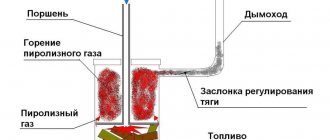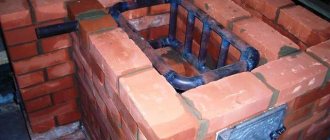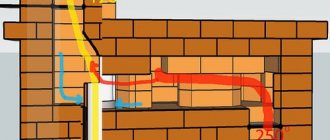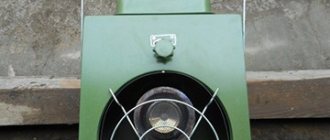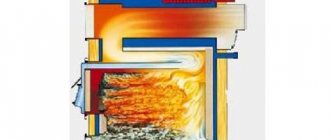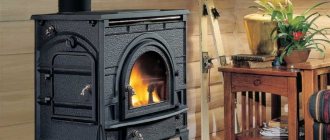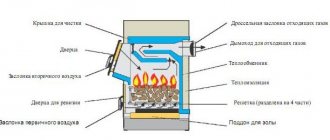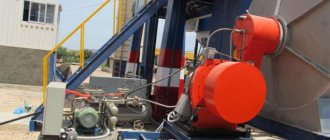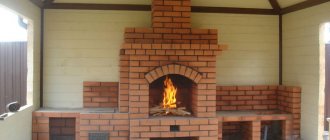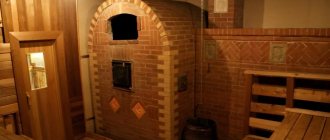A miracle stove is a special small heating device that is used to heat small rooms. The device runs on diesel fuel, but kerosene can also be used.
The miracle oven is a small rectangular body. In its rear part there is a special container for filling fuel, and in the center there is a removable tank (a bowl for a wick), which are connected to each other.
In the bowl there is a burner wick on a cylindrical base, and at the outlet pipe there is a valve that regulates the flow of fuel. At the top of the burner there is a screw for adjusting and controlling the device, and behind it there is a special reflective surface.
Principle of operation
The fuel gradually enters the annular reservoir and impregnates the fiberglass wick, which begins to burn. The gaseous mixture moves into the combustion chamber, in which it burns out gradually and evenly. The burner gives off heat, and the reflective stainless surface increases the efficiency of the device.
Special cylinders located in the combustion chamber provide the opportunity to use infrared heating mode, as well as convection. The stainless steel surface heats up to 800°C and begins to warm up the air in the room, and infrared rays, reflected from the screen, heat objects located in the room.
Design features of the miracle oven
In order for the manufacture of the described stove design to be successful, you must study the diagram of the miracle wood-burning stove, as well as its structure. The unit is an all-metal structure, which includes a firebox and bent metal tubes adjacent to it. There should be a door on the front panel through which you will load fuel. In addition, there is a device for adjusting power. With it you can change combustion modes. In the firebox there must be a secondary combustion chamber and a pipe, the outlet for which will be used by the chimney. Miracle wood-burning stoves will work more efficiently if you properly insulate the chimney. Experts advise using mineral wool for this, the thickness of which should not be less than 3 millimeters. You will also need a vent; air will flow through it into the firebox; it is necessary for the combustion of fuel. The craftsman can also work on creating an oversized ash pit, but during the slow burning process virtually no waste will be generated. The rear wall should be double; it makes the unit even more efficient. Some models are equipped with a double housing for this purpose.
Advantages and disadvantages
The positive qualities of the miracle stove include:
- Does not require connection to centralized heating or electricity.
- Small compact sizes.
- Available and inexpensive fuel.
- Low price.
- The presence of a screw that allows you to adjust the intensity of heat supply.
- The ability to use the device to heat food or water.
- There is no need to build a chimney, since there is no open fire from the stove.
- Device mobility.
- Low weight.
- Economical fuel consumption, about 200 to 400 g/hour.
- Convenient to use.
- For installation, you do not need to take out special permits or coordinate the project with the relevant authorities.
There are also disadvantages, for example:
- The appliance should not be used for continuous heating of a room, as it emits an unpleasant odor and may release smoke into the air.
- Requires periodic replacement of wicks.
- The device should be cleaned from time to time.
- Requires a specially equipped place and strict compliance with fire safety standards.
- Unpleasant smell.
Construction of a diesel fuel stove
What types of homemade stoves exist?
The skillful hands of a craftsman, in the presence of accurate and understandable drawings, can make different types of heating structures that fully provide heat to a small room, even without constructing a piping system and installing radiators.
Such devices include:
- Traditional potbelly stoves.
- Buleryan stoves.
- Furnaces under development.
Potbelly stove
Wood-burning potbelly stoves have been providing heat to residential houses, garages, greenhouses, sheds and other premises where the creation of a warm microclimate is required for decades. Such stoves are a simple metal barrel, usually second-hand, with fairly thick walls. First of all, it is necessary to make drawings, in accordance with which all work should be carried out.
The volume of the barrel must be at least 100 liters. All the work consists of dividing the internal space of the barrel into two compartments, one of which will serve as a combustion chamber, the second as an ash pan. To do this, a horizontal metal partition with a thickness of at least 5 mm is made in the barrel, in which holes are cut to remove ash.
Potbelly stove diagram
The lower compartment, which is an ash pan, is equipped with a retractable metal box where fuel combustion products are collected. On the front wall, a hole for the combustion chamber measuring approximately 40x40 cm is cut out with a chisel or by welding, and an opening for the ash pan, the size of which is 10–15 cm smaller than the combustion chamber. The combustion hole must be equipped with a door and a valve.
The top of the barrel is closed with a lid, in which a hole should be made for the chimney pipe. The lid itself is scalded around the perimeter by welding. In the future, the barrel must be placed on legs or a brick foundation to prevent the floor underneath from catching fire. Naturally, such a structure has many disadvantages. This includes low efficiency, since most of the heat is lost through the chimney pipe, rapid cooling, and the need to constantly add firewood to the firebox. But this is the most economical model, which you can make with your own hands in just a few hours.
Stove Buleryan
Construction of a buleryan
This type of wood-burning stove is much more expensive at cost than a simple potbelly stove. You can also make a similar design with your own hands, although you will need more professional skills of a welder and mechanic, as well as detailed drawings. Unlike a potbelly stove, in such a stove you can regulate the duration of fuel combustion, which can reach 10–12 hours with one load of firewood.
In addition to the fact that the heat comes from the stove itself, the room quickly warms up due to the hot air coming out of the pipes, which are present in the design of the buleryan stove and are its distinctive feature.
Furnace in production
Ideal for a garage.
It is not advisable to use such a design for heating a living space, since burning oil, in addition to unpleasant odors, also emits some carcinogenic substances, which are extremely harmful to breathe. Such stoves are most often used by car enthusiasts to heat the garage, given the availability of fuel, which you don’t even need to buy. Having primitive drawings in hand, any car owner can build such a miracle stove.
All of these stoves, despite the rapid heating of the room, have a number of disadvantages, which include low productivity, the need for constant control over the process of burning wood and the addition of fuel.
In long-burning furnaces, these shortcomings do not manifest themselves to the same extent.
How to choose a miracle oven
When choosing a burner, you should pay attention to the following criteria:
- Thermal power. It ranges from 1.8 to 5 kW. When choosing, you should proceed from the fact that 1 kW is capable of heating 10 m2 of space. The larger the area, the stronger the device should be.
- Material. Pay attention to the material from which the flask and burner are made. The body is made of metal or glass. The glass miracle stove is much more efficient, but is more expensive and requires very careful handling. It can be used exclusively for heating. If you plan to use the device for cooking, you should opt for a metal burner.
- Fuel consumption. The amount of diesel fuel consumed directly depends on the power of the device:
- with a power of 1.8 kW – 160 ml/hour;
- with a power of 2.5 kW and above - from 180 ml/hour.
Specifications
Heating elements consume 0.8 kW of electricity. Compared to a microwave, this figure is very low. The cord has a convenient and safe connector with sliding contacts. The diameter of the frying pan is 28 cm. The maximum volume of the container when completely filled will be 3.5 liters.
Good to know: How a Russian stove with a fireplace works, how to build it and where to place it
With such dimensions, the oven can be easily disassembled and placed on one of the shelves of the kitchen cabinet. European analogues are equipped with modern functions. This includes a thermostat, non-stick coating, insulated handles, and a pressure relief valve. But such options only increase the cost of the device. And again, our housewives give preference to the Russian manufacturer.
Original modification
Operating rules for the stove
There are several important operating rules that must be followed to avoid fires:
- Do not install the device in places with strong drafts.
- There should be no flammable objects near the structure.
- There should be a free space of 0.5 m around the stove.
- Any flammable substances, as well as rags that have been soaked by the treatment, should not be placed close to the device.
The device must be installed horizontally and levelly to achieve uniform combustion of the wick.
Ignition
You should start igniting outside, and when it has already flared up, bring it indoors to avoid unpleasant odors. If the device is not used for a long time, you should first clean it thoroughly.
Important! The device must be installed horizontally and levelly to achieve uniform combustion of the wick.
Ignition step by step guide:
- The principle of operation of a diesel fuel heater
Fill the removable tank with diesel fuel.
- Install a new filter into the burner.
- Replace the burner, as well as the removable tank.
- Unscrew the valve to allow fuel to flow to the wick.
- Open the front door and light a heating pad from underneath.
- As soon as the fuel ignites and the flame is above the grate, the valve should be fully tightened.
- When the fire begins to die down, open the valve and set it to the desired intensity.
To turn off the device, simply close the valve completely.
If you can't get an even blue flame across the entire wick, you may have one of the following problems:
- the device is installed on an uneven surface;
- the burner cylinder did not have time to warm up;
- The wick is worn out.
Advice! To extend the life of the wick, it should be washed in kerosene from time to time. In addition, you can turn it over or cut off the burnt edge.
Precautionary measures
As a precaution, you should purchase a small carbon dioxide fire extinguisher. The volume of the fire extinguisher should, according to calculations, exceed the cubic capacity of the room by 1.5 times.
A fire extinguisher weighing 5 kg is considered optimal. Of all the types, it is preferable to choose the following models:
- carbon dioxide;
- automatic;
- non-volatile.
It is not recommended to experiment with different types of fuel. It is best to use the type that is indicated in the product passport.
Price
Prices for a miracle oven vary and depend on the power of the device, material, manufacturer, and size. Approximate prices for some models of domestic and foreign production are indicated in the table.
| Name | Power, kWt) | Manufacturer | Price, rub.) |
| Solarogas Savo PO-1.8 Mini | 1,8 | Russia | 1850 |
| Savo PO-2.5 | 2,5 | Russia | 2450 |
| Aeroheat HA S2600 “BOXER” | 2,6 | Russia | 3000 |
| NeoClima KO-3.0 | 3,7 | Korea | 8500 |
| Kerona WKH-2310 | 2,55 | Korea | 5500 |
Feedback about use
Evgenia, Novaya Ropsha village, Leningrad region. We use this stove. We use it for the greenhouse in the spring during severe frosts. There is a smell from it all the time, although the store said that it was only at the beginning. Also, I have buckets of water in my greenhouse as heat accumulators. After the stove operates on water, a gasoline film appears. Our device is adjusted perfectly, but there are these unpleasant little things. I wouldn't use it inside the house.
Alyonushka, St. Petersburg. We have such a thing at home. My husband is very pleased with it, simply delighted. True, at first there were problems with it, it burned poorly, or something else was wrong, but over time everything got better. As for me, my husband has problems with charm, it stinks disgustingly, and makes a buzzing sound. But when there is no electricity, it helps a lot.
Alexey Petrovich, Moscow. I use the unit in the kitchen or in the hallway, I don’t leave it overnight, so everything functions quite well and brings the cold dacha to a normal and comfortable place to live. There is a smell, but if you compare it with the summer smells of Moscow, it’s just flowers. There are no difficulties with control. You just need to keep an eye on the filter so that it doesn’t burn out too much, otherwise it will cause unstable operation with soot or a yellow flame. Excellent ratio of price, quality and benefits.
Angelina, Moscow. We have been using the burner for 4 years now. It works great in May and October. There is, of course, a gas stove, but it warms up the room very slowly. Sometimes we even cook with it. If you consider the price, heat and speed of work, then it is simply priceless during the construction period. This year we will install Bulleryan, but these 4 years it has helped us out a lot.
Ahela, Moscow. Maybe in advertising the device can be called a miracle oven. We use it in the cabin when necessary, since there is no electricity yet. We even got used to adjusting it, but when it works, I feel like a truck driver, it seems to me that there is exactly the same smell coming from the inside of the cabin.
Do it yourself
Building a heating device yourself is a very costly, time-consuming and labor-intensive process. It justifies itself only when its cost is lower than the price of factory development. For a miracle oven, this process is unjustified, but everyone decides for themselves what is best.
There are several types of diesel heaters.
Gas cylinder heater
For production you will need:
- A balloon without seams with a wall thickness of less than 1.5 cm.
- Chimney pipes 4 m long and over 10 cm in diameter.
- Fuel tank with a capacity of up to 15 liters.
- Copper pipes.
- Grinder and welding machine.
- Steel angles.
The process of supplying diesel fuel proceeds by gravity. It does not require additional elements to warm the air. The combustion source must be at the same height as the circuit. This prevents the oven from overheating to a fire hazard temperature.
Manufacturing instructions:
- Using a grinder, cut the balloon into two even pieces. One of them will serve as a cover, the second as a camera.
- Weld metal corners to the chamber to form legs.
- Using a welding machine, make a small hole in the lid for an exhaust pipe with a diameter of 10 cm. The hole should be made at a distance of 15 cm from the edge.
- Make a small hole in the housing , which will be used to regulate air flow. It will be covered by a special plate.
- Measure 10 cm from the welding point and make a hole 3 mm in diameter at the resulting point. Using this principle, 10 more holes should be made, the last of which will be located at a distance of 0.5 m from the welding point.
- Drill a hole in the pipe for a pipe with a diameter of 8 cm and a length of 4 m. It should be mounted parallel to the floor and welded well.
- To fill the fuel liquid, an additional hole with a diameter of no more than 8 cm should be made in the lid.
The combustion source must be at the same height as the circuit, this helps prevent the stove from overheating to a fire-hazardous temperature
Drip type stove
An oven with a drip operating system is very easy to manufacture. As a rule, it is used to heat a small area of rooms.
Manufacturing instructions:
- Make a preliminary calculation of the area that will be heated. For example, for a room measuring 3 by 3 meters, a box with dimensions of 30x30x45 cm will be sufficient.
- For a small stove, you can use a container from a fire extinguisher ; for larger ones, you can use a container of 200 liters.
- For a container for diesel fuel, a container with a volume of 2 liters is sufficient; for example, you can use an ordinary medical burner. To connect it, connect the rubber hose of the burner at an angle of 90 degrees with a copper pipe with a small diameter and a length of 1 m.
- The hose should be bent in half and secured with a clamp to secure the stove parts. The adjusting screw should be mounted so that the flow of liquid is drip.
- Instead of a wick, you can use a rag soaked in diesel fuel.
- Install the door.
- Make a hole in the center of the body to match the diameter of the copper pipe.
- If you plan to use the device for cooking , you should mount the tube not on top, but on the side.
Step-by-step instructions for making a long-burning stove with your own hands
1. To make the stove body, use a grinder, which is used to carefully cut off the top of the metal barrel. Of course, in the case of using a container with a thickness of more than 3 mm, the use of a gas cutter will be more justified. We remind you once again that the work must be done carefully - the furnace lid will be made from the cut part in the future. If a pipe is used as a body, then it is necessary to weld a bottom cut from sheet metal 5–6 mm thick to it.
When cutting off the cover, remember that this element will be needed later
2. In the lower part, four legs from a channel or angle are mounted to the body using a welding machine. Note that if the body is made of metal and has a rectangular shape, then you can do without additional supports.
One of the options for arranging support legs
3. Using the same grinder or autogen, an air distributor is cut out of sheet steel 5-6 mm thick - a circle that can fit into the barrel with a small gap. The edges of the metal pancake must be thoroughly cleaned to prevent the possibility of touching the walls of the oven.
4. A hole with a diameter of 20 mm is cut in the center of the air distribution device and a pipe is welded to supply air to the combustion zone.
The blades of the air distribution device are mounted at the same distance
5. On the back side of the flat piston, four sections of a channel or angle are welded, evenly positioning them in a circle. Note that the blades should not protrude beyond the air distributor. In the future, thanks to these elements, there will be an air gap between the metal pancake and the firewood, which is necessary for fuel combustion.
As a result, the air distribution device should look like this
6. A lid is made from the previously cut off top of the barrel. To do this, a metal strip is welded from the outside along the entire contour so that its diameter allows the top of the stove to be freely installed on the body.
Making the lid
7. A hole is cut in the lid, 3–5 mm larger than the diameter of the air duct pipe. In addition, two handles made of strips of metal are welded onto its top. With their help, it will be easier to open the hatch for loading fuel.
8. A hatch for cleaning the oven is cut out in the lower part of the body. Try to do this part of the work using a grinder with a thin circle installed. This will ensure a more precise fit of the door to the body. A thin metal strip is welded along the perimeter of the hatch to eliminate the resulting gap. Then the hinges are welded, the structure is installed on the body and the valve is mounted.
9. On the other side of the stove, at a distance of 50–100 mm from its upper cut, a smoke exhaust pipe is cut in. It is used as a piece of steel pipe, into which the chimney will fit with a slight interference.
Installation of a smoke exhaust pipe
It is better to use a chimney of a collapsible design, consisting of several sections - it will be easier to clean during operation.
At this point, the production of a vertical-type solid fuel unit can be considered complete. All that remains is to install the stove in place and connect the chimney.
Long burning stove: final version
Blitz tips
- When buying a miracle stove, opt for a metal burner type. It can be used as a cooking surface. The glass type of burner, although more efficient, requires special care; if a drop of water gets on the surface, the glass may burst.
- Monitor the condition of the wick. Its timely replacement and periodic impregnation in kerosene will allow you to avoid problems in the operation of the device for a long time.
- Be sure to buy a fire extinguisher to quickly put out a fire and prevent a fire.
Proper operation and compliance with fire safety standards when using a miracle stove will allow you to quickly, economically, and most importantly, effectively heat the room.
Miracle oven design
- removable fuel tank equipped with a valve;
- adjusting screw;
- a block with a wick that can be changed;
- lattice;
- frame;
- reflector;
- burner.
The metal reflector is located on the body, which is powder coated. It is thanks to the reflector that the room is effectively heated . The burner is located in the center of the miracle stove, and the fuel flows by gravity from the fuel tank located on the rear panel. Using the adjusting screw, the required room heating temperature is set. This is the general design of a diesel stove, but it may vary slightly between models from different manufacturers. is used to make the stove .
The weight of the miracle stove can be 10 kg, which allows it to be moved, depending on the need, to another room. Dimensions: height from 3500 to 6000 mm, depth and width from 2500 to 4000 mm. Such light weight and small dimensions allow it to be moved with the strength of one adult.
Ignition
Before ignition, the tank is installed in the designated place and fuel is poured into it. Then you need to remove the grate with the burner and install the wick into the block. After the wick is inserted, the burner and grate are reinstalled. After all the preparatory work is completed, the adjusting screw opens and you will need to wait half a minute for the wick to become saturated with fuel. Then the burner is ignited. As soon as intense combustion begins, the adjusting screw needs to be turned all the way and, after waiting some time for the flame to settle, open it back, setting the required degree of heating. The operation of the miracle oven is stopped by screwing the adjusting screw all the way. Be sure to ensure that the fuel burns out completely and the fire goes out. Fuel consumption, depending on the design of the stove, can be 150−400 ml/hour.
Video illustrating the process of igniting the miracle stove:
Precautionary measures
Prohibited:
- use the heating device in a poorly ventilated area;
- install the stove in close proximity to furniture and flammable objects;
- use fuel that does not correspond to that specified in the passport data;
In addition, it is necessary to prevent water and it should be operated only under the supervision of adult family members.

